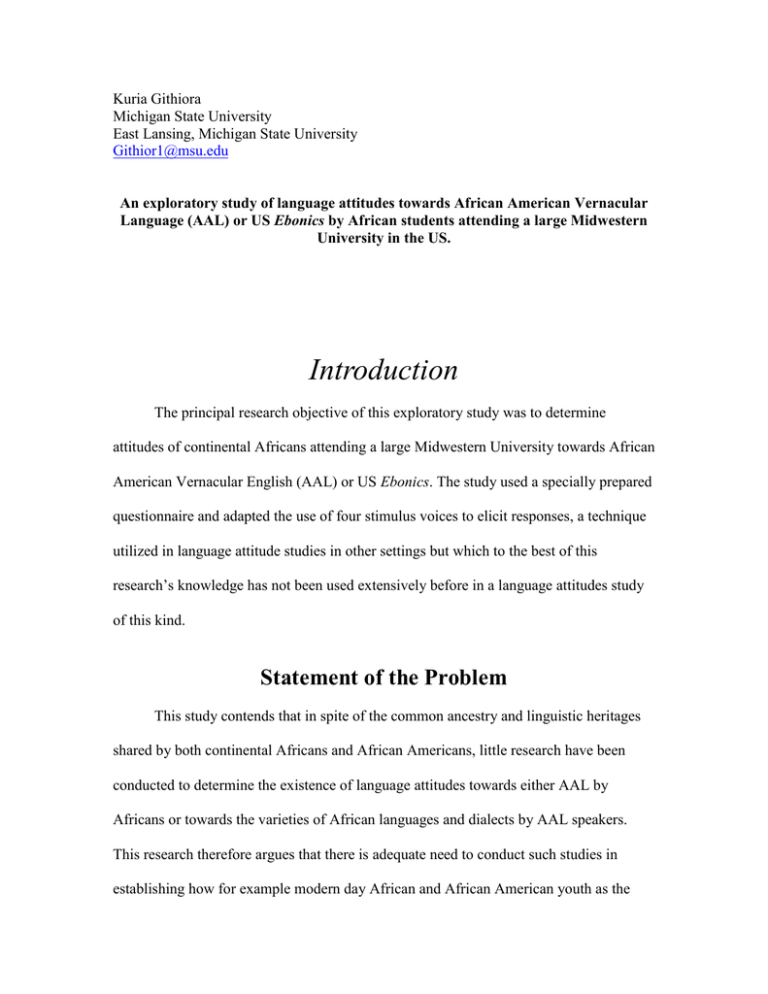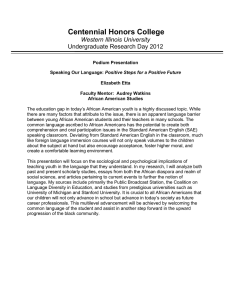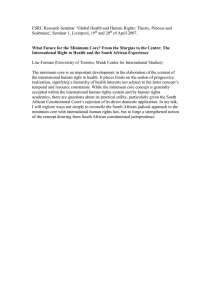Kuria Githiora Michigan State University East Lansing, Michigan State University
advertisement

Kuria Githiora Michigan State University East Lansing, Michigan State University Githior1@msu.edu An exploratory study of language attitudes towards African American Vernacular Language (AAL) or US Ebonics by African students attending a large Midwestern University in the US. Introduction The principal research objective of this exploratory study was to determine attitudes of continental Africans attending a large Midwestern University towards African American Vernacular English (AAL) or US Ebonics. The study used a specially prepared questionnaire and adapted the use of four stimulus voices to elicit responses, a technique utilized in language attitude studies in other settings but which to the best of this research’s knowledge has not been used extensively before in a language attitudes study of this kind. Statement of the Problem This study contends that in spite of the common ancestry and linguistic heritages shared by both continental Africans and African Americans, little research have been conducted to determine the existence of language attitudes towards either AAL by Africans or towards the varieties of African languages and dialects by AAL speakers. This research therefore argues that there is adequate need to conduct such studies in establishing how for example modern day African and African American youth as the future leaders of tomorrow perceive one another. It is therefore a great opportunity in this research’s view to utilize the presence of continental African students in US college and university campuses in embarking on such a mission as part of strengthening and perpetuating Pan African ideals amongst Africans around the world. Hypotheses This research worked with the following hypotheses: a) Respondents from each African region will have a more favorable attitude towards the variety of English they are more familiar with and that they will rank this variety higher than the other variety. b) Respondents from all the African regions will rank the more familiar variety or varieties as more prestigious than the unfamiliar variety. Research Question a) Can the respondents correctly identify both the African American Language (AAL) and Standard American English (SAE)? The Study’s Significance This is an exploratory pilot study whose goal is to explore ways of enhancing empirical language attitudes research in the study of African American language (AAL) variety in recognition of this unique language variety spoken in the US. This study also aims at testing methods and theories used in similar research in both monolingual and bilingual areas of the world. As an example, Múngai Mútonya at Michigan State University made useful contribution with his investigation of regional African forms of English in his M.A. thesis titled: Language Attitudes of Educated Africans towards varieties of African English (1997). Equally, the Ebonics controversy sometime back in the Oakland School District, CA is instructive and as John Baugh suggests in his book: Beyond Ebonics, it Enhanced linguistic awareness and a better understanding of the linguistic consequences of American slavery represent important new beginnings of racial healing. Part of the healing began when Oakland decided not to pursue its Ebonics agenda. Without fanfare or the potential embarrassment of a public apology, Oakland educators quietly dropped all references to Ebonics in their reformulated educational plans. (2000:112) For this research then, positive attitudes towards linguistic issues coupled with well thought research strategies for those in the academia for example in collaboration with community leaders within the praxis and bossom of the African American community are critical in the constant re/negotiating for linguistic democracy amongst other issues in today’s world. This study also argues that a good and coherent research argument, sometimes quietly pursued but well coordinated between the academy and community is likely to be more meaningful to us as a Pan African community. This study will hopefully contribute meaningfully in this regard especially in adopting past research paradigms such as the Labovian research framework in engineering new and innovative useful methods in AAL linguistic research. The Sample Given limited time and resources, this was a convenient sample and the evaluators included 12 female and male African students currently attending this large Midwestern University for both their undergraduate and graduate studies. All respondents had lived in the US for a period of 2-12 years. Their age ranged from 18-43 years. Each of the 12 respondents was asked to evaluate each of the four stimulus voices recorded from two African American graduate students able to code switch between AAL and Standard American English (SAE) on a semantic differential scale. The sample included: a) Four respondents from East Africa: included two females and two males who included three graduate students and one undergraduate ranging in age from 18-43 years. They spoke Ki/Gìkúyú (total =2: One graduate male and one graduate female student) and Ki/Meru (One undergraduate female and one graduate female student). All four spoke Ki/Swahili as the national language. They all come from Kenya. The all spoke English as a second language. b) Four respondents from West Africa: included two females and two males who included two undergraduate female students and two male graduate students. They ranged in age from 18-39 years old. They spoke Yoruba as their first language (included 3 Nigerian students: two male graduate students and one female undergraduate student) and one female undergraduate student from Mali who speaks Mandingo as her first language). c) Four respondents from Southern Africa: included two female and two male students. They included two male graduate students from Zimbabwe and the Republic of South Africa who speak Shona and Xhosa respectively as their first languages and one female graduate student from Zimbabwe who speaks Isi/Ndebele as her first language and Shona as her second language. It also included one female undergraduate student from Malawi who speaks Bemba as her first language. Most respondents spoke English either as a second or third language but certainly as the official language and school language in their home countries. Voice Stimulus The voice stimulus samples were selected from two African American students from Indiana and Illinois in the Midwest. One is a female student aged 39 years old and one is male aged 32 years old. They are both advanced linguistics graduate students attending the large Midwestern University. They were identified specifically for this pilot study because of their ability to code-switch between AAL (African American Language and SAE (Standard American English). Both were asked to speak for three minutes or so in both AAL and SAE on a topic of their choice. Their voices were tape-recorded by this investigator. Data Collection Methods This study has identified speakers of African American Language (AAL) and Standard American English (SAE). The method and procedure used is based on the knowledge of AAL speakers when contrasted with SAE speakers. The researcher is an African who has attended college in the US for more than five years. He has also interacted with the two types of speakers on a daily basis for the same amount of time. As an AAL user and researcher and in recognition of the differences between the two language varieties, Geneva Smitherman remembers her own experiences in Talkin the Talk: Language, Culture and Education in African America (2000) argues that I recall two of my key areas were the post-vocalic –r sounds in words like “four” and –th sound in words like “mouth” and “south” (for me, “mouf” and “souf”). These patterns that I know reflect West African language influence dating from the enslavement era. But there I was living in the hood sayin “mow” and “so.” (2) Smitherman is an authority in AAL research over the past several years and her work is a useful guiding light for this study. Data Elicitation of language attitudes using the Semantic differential scale While there exists several research techniques that have been developed for language attitude research, this study has used a form of the pure matched-guise technique developed by Wallace Lambert and his associates (Lambert el 1960: Lambert, 1967). This technique aims at total control of all variables except language. To achieve this, a number of bilingual speakers for example fluent in the languages under investigation are recruited. The Scoring procedure on the Semantic differential scale After responses are collected, numbers are assigned to each of the spaces on the scale. In the seven-point scale such as the one shown as Appendix B in this report, a 7 might be assigned to the space nearest to the word ‘friendly,’ a 6 to the next space, etc. As responses are tabulated, a circle is made around the numbers on the scale or a tick mark is made on the blank at each space on the scale for each listener who placed his evaluation of that speaker at that space. For example, a speaker in a particular guise maybe judged a 7 for ‘intelligence’ by five listeners, 6 by thirteen, 5 by twenty, 4 by eleven, 3 by two and 2 by one, etc. In the past, Tucker and Lambert (1972:178-84) have used the following adjectives to determine the attitudes of whites and African American students towards various American English dialects: upbringing, intelligent, disposition, speech, faith in God, talented, character, personality, and considerate, among other adjectives. This research tested for recognition of AAL along eleven adjectives and characteristics and in so doing also tested for the positive or negative attitudes towards this English language variety amongst African students attending a large midwestern university using content-based audio stimulus. Four voice stimulus samples comprising 4 speakers were recorded in an audiocassette, which was then played back to the African students in order to test for recognition of whether the voices were AAL or SAE. The four speakers were: a) AAL female speaker using AAL b) AAL female speaker using SAE c) AAL male speaker using AAL d) AAL male speaker using SAE Consequently the eleven characteristics used for rating by the listeners/respondents in this study were: 1) Well educated or not well educated 2) Confident or not confident 3) Responsible or not responsible 4) Gentle or not gentle 5) Friendly or not friendly 6) Polite or not polite 7) Leader like or not leader like 8) Patient or not patient 9) Proud or not proud 10) High status or low status 11) Trustworthy or not trustworthy Data analysis After the twelve African evaluators had rated the four voices, analysis was done to determine the raters’ attitudes towards the two varieties of English language varieties spoken in the US, namely: African American Language (AAL) and Standard American English (SAE). Their rating of the four voices on a semantic differential scale is considered a reflection of their attitudes towards the two English language varieties. In order to analyze the resulting data effectively, a Statistical Program for Social Sciences (SPSS) computer program was utilized to calculate the mean score for each individual voice on each of the eleven adjectives and characteristics cited in the section on the Scoring procedure on the Semantic differential scale. A method used by Tucker and Lambert (1972) of ranking each trait or characteristic was used to determine how the respondents judged and evaluated each voice for each trait. The mean score was then calculated for all other measured features. The mean score was used to obtain a quick estimate of the evaluators’ attitudes towards the two language varieties. Following Lambert and Tucker’s method of analysis, the scores indicated tentatively the evaluators’ preferences of the voices and how they associated the four voices with the different traits. For future reference, it is suggested that a factor analysis and a correlation coefficient matrix for each African region be conducted in order to determine the degree of correlation of the traits based on their level of significance. Though not used in this study and while the correlation coefficient may not be as efficient as the factor analysis, for example, it is useful in exploratory studies. In combination, the two methods are likely to generate useful data and point towards future research directions for a study of this kind. Main Findings The study’s results indicates that on average, Speaker One, was correctly identified as an African American Language (AAL) female speaker by the majority of the evaluators on the trait of being well-educated with a mean score of 1.67 on a scale of one to seven adapted from the much more often used matched-guise semantic scale by Osgood, Suci, and Tannebaum (1957). She was judged to be well-educated to the degree of a bit less than 2 on a seven-point scale where 1 is for being extremely well-educated and 7 is for being not well educated at all. The lowest rating for Speaker One was for being patient with a mean score of 3.75, which means this speaker was on average rated by the majority of the 12 respondents as being between being patient to not being so patient. On the other hand Speaker Two, correctly identified by the majority of the respondents as SAE female speaker was rated highest on being well educated and polite with a rating of 1.91 on both occasions. She was however rated lowest with a mean score of 3.25 for being proud. There may have been confusion as what proud means across the African and American cultures. Speaker Three was correctly identified by the majority of the respondents as an AAL male speaker and scored highest for being gentle and also for being friendly with mean scores of 2.58 in both cases while his other mean score for the other characteristics varied from a mean score of 2.83 for being confident to a mean score of 4.41 for being not so trustworthy and for being somewhat trustworthy. The overall mean scores for this AAL male speaker ranged from 2.58 to 4.41. Speaker Four was correctly identified as a SAE male speaker by ten of the twelve respondents. The highest mean score for this speaker was being gentle with a score of 2.08 on the 1 to 7 semantic differential scale while his rating was lowest for being friendly with a mean score of 3.08. The scores for this speaker on all the eleven traits ranged from 2.08 to 3.08. Future research directions As suggested, the potential to replicate this study’s preliminary findings using various research approaches such as combining qualitative and a quantitative methods remain immense. The use of additional statistical data analyses is also likely to generate additionally more interesting findings. It is hoped that this exploratory study has opened a unique direction in its limited attempt to understand language attitudes towards AAL by African students from the Motherland. Inversely, the study can also be used in much more extensive studies of language attitudes towards both African and/or European languages based on socio-economic class, educational level, gender or cultural and/or political persuasions. Works cited 1. Baugh, John. Beyond Ebonics: Linguistic Pride and Racial Prejudice. Oxford: Oxford University Press, 2000. 2. Lambert, W.E. et al. “Evaluational reaction of Jewish and Arab adolescents to dialect and language variations.” Journal of Personality and Social Psychology, Volume 2 (1965), 84-90. 3. ------------------------. “Evaluational reaction to spoken language.” Journal of Abnormal Social Psychology (1960), Volume 60, 44-51. 4. Labov, William. Language in the inner city; studies in the Black English vernacular. Philadelphia: University of Pennsylvania Press, c1972. 5. Mútonya, Múngai. Attitudes of educated Africans towards Regional varieties of English (M.A. Thesis). East Lansing, MI: Michigan State University, 1997. 6. Osgood, C.E., Suci, G.J., & Tannenbaum, P.F. The measurement of meaning. University of Illinois Press, Urbana, Ill., 1957. 7. Smitherman, Geneva. Talkin The Talk: Language, Culture and Education in African America. London: Routledge Publishers, 2000.




